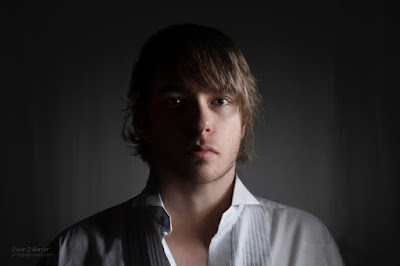There are many aspects of portrait photography that will help
set the mood and allow dramatic
1) Split Lighting
2) Rembrandt Lighting
3) Butterfly Lighting
4) Loop Lighting
5) Flat Lighting
1) Split Lighting
With split lighting, the face is basically split in half with one side shadowed and the other side with light. Split lighting offers a dramatic effect to an image.
To achieve the split lighting effect, place your light source (studio light, window light, sunlight etc) 90 degrees to the left or right of the subject.
The line separating light and shadow will be down the middle of the nose and chin.
2) Loop Lighting
Loop lighting is one of the most flattering lighting effects for any subject. Loop lighting is created when a small shadow of light (slightly loop shaped) is formed on the side/slightly under the subjects nose. The shadow does not appear directly under the nose, but slightly on the side, reaching in toward the side of the face. It can be small and subtle or can stretch all the way down to the corner of the mouth. Below is one example of loop lighting:
To create loop lighting, the main light is positioned 30-45 degrees from the camera around the subject's side. The light source should be higher than eye level and pointing down toward the subject's face in the direction they are facing.
An additional light source (fill light) or reflector can also be aimed at the darker side of the face to ease the shadows. Be sure to not place your reflectors down low angle up. This will result in an unflattering effect.
3) Rembrandt Lighting
Rembrandt lighting is achieved by creating a triangle of light on the cheek. Rembrandt lighting is more dramatic (similar to split lighting) and creates a moody, darker feel to the portrait. The more shadow we add to our subject and the more we turn our light away from flat lighting, the more dramatic our lighting becomes! Below is an example of Rembrandt lighting:
To create Rembrandt, lighting, the subject should be turned slightly away from the light. The light should be above the top of the head. Move your main light around the subject until the shadow of the nose is touching the shadow of the face. This should leave on side of the face in shadow but keeps a triangle of light on the cheekbone and eye.
4) Butterfly Lighting
Butterfly lighting creates a shadow under the nose that resembles a butterfly! Butterfly lighting is also known as Paramount Lighting named after classic Hollywood glamour style photography.
Below is an example of butterfly lighting:
To achieve butterfly lighting, place the main light source directly behind the camera and slightly above the subject's head. The photographer will be shooting underneath the light source. You may need to place a reflector directly under the subject's chin (or the subject can hold it under his/her chin if necessary). This light pattern is a little more difficult to create using window light or a reflector alone. A harder source of light like the sun or a flash is usually needed to achieve this look. Butterfly lighting will create shadows under the cheeks and chin. Butterfly lighting isgreat for older subjects because it tends to minimize wrinkles!
5) Flat Lighting
Flat lighting is the least dramatic of all the lighting patterns because it casts the least amount of shadows on the subject's face. Flat lighting is used mainly for headshots and glamour editorial type shots because it minimizes the amount of wrinkles and imperfections. Below is an example of flat lighting:
To achieve flat lighting, place your main light in front of the subject in the same direction where you will be shooting.



No comments:
Post a Comment